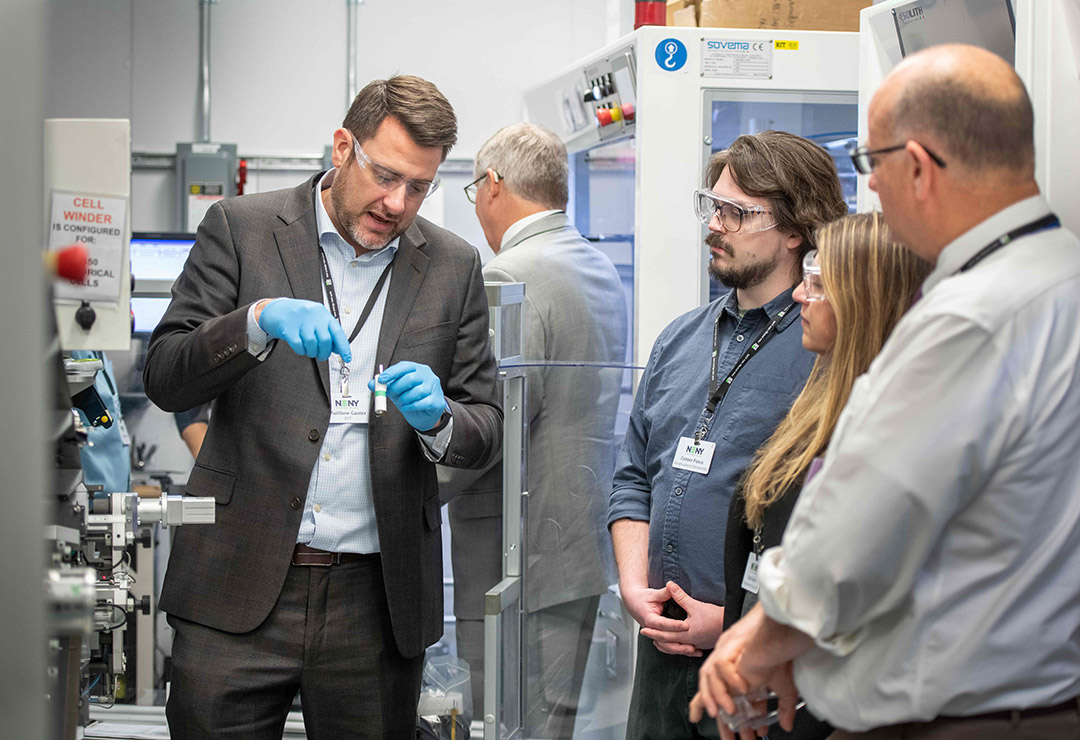RIT’s Battery Prototyping Center merges with NY-BEST Test and Commercialization Center
Battery development and storage ecosystem emerges as a comprehensive resource to contribute to regional and national economic growth
Carlos Ortiz/RIT
Matthew Ganter, left, demonstrated battery technologies during a recent event at RIT’s Battery Development Center. He will lead the merged NY-BEST/RIT Battery Development Center.
The Battery Prototyping Center at Rochester Institute of Technology and the Battery and Energy Storage Technology (BEST) Test and Commercialization Center have merged to become a comprehensive battery development enterprise in New York state.
The university-led merger, which was announced on May 16 during the annual Capture the Energy 2024 Conference and Expo in Albany, N.Y., will be designated the RIT Battery Development Center, in partnership with NY-BEST. It brings together two distinct areas of expertise necessary for battery development and energy storage initiatives—the prototyping, training, and research capabilities based at RIT, and the systems safety and life-cycle testing, certification, and commercialization expertise of the center.
RIT
Martin Plass, director, Battery Development Center’s Energy Storage Testing
Battery technologies are essential for myriad industries including the automotive and medical device industries as well as for defense and national security. The demand for batteries has increased and U.S. industrial leaders are moving toward a goal of securing a stronger lithium supply chain by 2030.
According to Ryne Raffaelle, RIT vice president for research and associate provost, the new center will streamline technology development, accelerate time-to-market, provide a neutral space for companies to explore battery technologies, and allow for broad training experiences for next-generation engineers and technicians.
“The Battery Development Center will be a one-stop shop for all battery development needs and is a significant addition to the lithium ion battery ecosystem,” said Raffaelle.
Integrating industry and academic collaborations can expand research, prototyping, and testing processes and provide a centralized platform to connect all sectors in the broad range of battery and storage technologies in New York and the United States,” said Matthew Ganter, director of the RIT Battery Development Center (BDC) and assistant research professor in the university’s Department of Chemical Engineering.
“We may be the only university with this level of service, and this merger is a way to enhance what both facilities do well and to expand capabilities,” he said.
Ganter has seen demand for services in RIT’s Battery Prototyping Center increase significantly since it was established in 2015 with projects reaching the facility’s maximum capacity. The prototyping space at RIT is expanding over the next year to accommodate demand, doubling in size.
To date, the Battery Prototyping Center has attracted significant funding from federal and state research organizations and user fees through work with 63 different companies and national laboratories.
The BEST Test and Commercialization Center, established in 2014, and located at the former Kodak industrial park in Rochester, has had similar success. The lab provides services that range from systems testing to essential third-party certifications of single cells to connected battery packages and lifecycle, performance, and safety measures. The test center has worked with more than 100 companies since it began, logging more than 7.5 million cycle testing hours.
“It is independent data from a lab like ours that companies trust. Industry needs to verify that battery storage perform as promised, and that it is viable in the long run,” said Martin Plass, director of BDC’s Energy Storage Testing.
The new center will be managed overall by Ganter. Additional resources will include new business development responsibilities as well as formal processes to integrate new research avenues and student-faculty connections.
Transitioning to a central hub provides a bridge to services that will benefit current businesses to start-ups as well as supply chain partners.
“This is great forward momentum and as these key development and manufacturing initiatives become even more integrated, the economic impact will be felt beyond the state,” said Raffaelle.
Later in the summer, the university will host a dedication and tour of the facilities.





